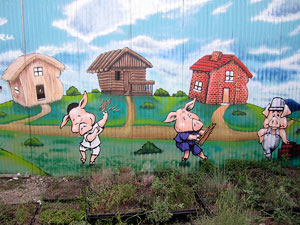
Source: Three Little Pigs, Verbunkos, Flickr
Bricks and Straw
Once upon a time a long, long time ago, before cell phones and Twitter feeds, there lived a community of pigs. These weren’t your ordinary, run-of-the-mill pigs, though. These pigs could walk and talk. They held down steady jobs and had families. This story is about three of these little pigs and what happened when trouble came howling at their doors.
This, of course, is the beginning of the familiar children’s story “The Three Little Pigs.” You know the what of the story, or the plot, characters, and setting, but what about the why? Why was the story written in the first place? In other words, what is the theme of the story? Sometimes, answering the “why” question is easy. The author may even state the answer right out in the open, explicitly. Other times, however, determining the theme is not so easy, and you have to use the clues the author leaves to figure it out yourself.
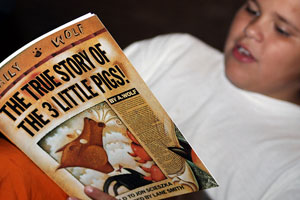
Source: Scieszka Visit-9859, Skokie Public Library, Flickr
Note: This is how it works: The author implies information about the story through plot points, setting, and characters. You infer and draw conclusions based on those bits of information. Keep in mind that this imply/infer relationship comes in handy when you analyze literature for almost any purpose: theme, characterization, motif, genre, etc.
For instance, in “The Three Little Pigs,” the author shows us that living in a house made of bricks is better than living in one made of straw, especially when a hungry wolf is part of the cast of characters. Of course, this is never explicitly stated; instead, it’s implied. Knowing this, what do you suppose the theme of the story is? Could it be that good planning can lead to success or that making smart choices is important? It may be both because a work of fiction can have many themes. Why? That’s simply because different people read differently, so it’s entirely possible that they find different meanings in the author’s words.
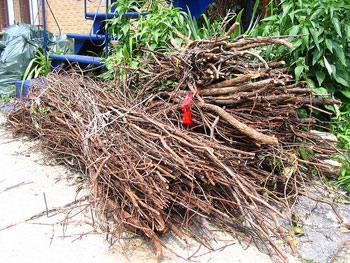
Source: Bundles of sticks, Steve Bissonnette, Flickr
Here is an audio presentation of one of Aesop’s fables.
Click on the player to hear the fable “The Bundle of Sticks,” and then answer the question that follows.

- What is the theme of Aesop’s fable “The Bundle of Sticks”?
In Aesop’s fables, the theme is stated explicitly in the last line of the fable. Of course, this is not always the case in literature or even in some children’s stories. Often, the reader has to think BIG to discover the theme. You need to consider the plot, characters, conflict, and action in the story in terms of what the author might be saying (implying) about the bigger picture of human life.
Although there isn’t a foolproof list of questions that will lead you to infer theme, here are a few to consider:
- Are certain thoughts, points, or actions frequently mentioned in the text?
- What is the problem (conflict), and how is it solved?
- Are there any details in the story that may have greater meaning than the other details?
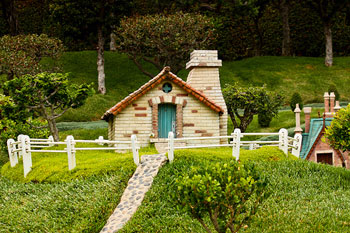
Source: A House Made of Brick, Omnitographer, Flickr
In “The Three Little Pigs,” certain elements are mentioned more than once: building a house with various materials, the huff and puff of the wolf, the attitudes of the three individual pigs. The repetition of elements in a story can help focus your attention on those elements. The main problem in the story seems to center around building a house that is a safe place to live. Each pig takes a different approach. Some details in the story may have greater meaning than others, particularly the way the three pigs decide to build their houses. Two of them choose to build simpler homes because they would rather play than work, while the third pig decides to build the very best (strongest) house he can. These differences can lead you to believe that the theme of the story has something to do with the third pig’s decision to build a strong house. In the end, the other pigs fall victim to the wolf (the result of their short-sightedness), while the more industrious pig outsmarts him, thus reaping the benefits of working harder. The theme, then, could be that it pays to always do the best you can do.
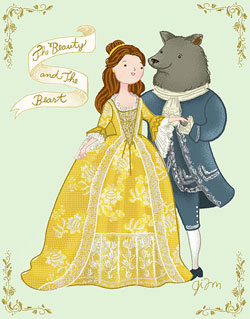
Source: A Bela e a Fera - The Beauty and the Beast,
Giovana Milanezi, Wikimedia
What are the themes of “The Three Little Pigs”?
Sample Responses:
Hard work pays off.
Be prepared.
Always do your best.
What are the themes of “Beauty and the Beast”?
Sample Responses:
Looks can be deceiving.
You can’t judge a book by its cover.
What are the themes of “The Boy Who Cried Wolf”?
Sample Responses:
Be honest.
What are the themes of “The Ugly Duckling”?
Sample Responses:
Individuality, patience, and self-confidence are important values.
What are the themes of “The Wizard of Oz”?
Sample Responses:
Things you seek are already inside you.
Appreciate what you have.
Nothing is more important than friendship.
Themes are what the story teaches readers. They often address timeless questions that we all wonder about, questions about love, betrayal, greed, truth, vengeance, fate, redemption, prejudice, suffering, jealousy, and loneliness.
Do you remember how you can figure out the theme of a story? Connect bits of information from the story—plot points, conflict, characterization, and setting—and make logical guesses and predictions. Base your guesses and predictions on the conclusions you draw from the information collected.
In the next section, we will examine how authors of various nationalities express their views on life in similar ways. Literature is a way for people all over the world to connect to each other through similar themes.